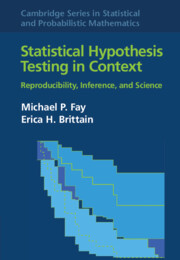Book contents
- Frontmatter
- Contents
- Preface
- 1 Introduction
- 2 Theory of Tests, p-Values, and Confidence Intervals
- 3 From Scientific Theory to Statistical Hypothesis Test
- 4 One-Sample Studies with Binary Responses
- 5 One-Sample Studies with Ordinal or Numeric Responses
- 6 Paired Data
- 7 Two-Sample Studies with Binary Responses
- 8 Assumptions and Hypothesis Tests
- 9 Two-Sample Studies with Ordinal or Numeric Responses
- 10 General Methods for Frequentist Inferences
- 11 k-Sample Studies and Trend Tests
- 12 Clustering and Stratification
- 13 Multiplicity in Testing
- 14 Testing from Models
- 15 Causality
- 16 Censoring
- 17 Missing Data
- 18 Group Sequential and Related Adaptive Methods
- 19 Testing Fit, Equivalence, and Noninferiority
- 20 Power and Sample Size
- 21 Bayesian Hypothesis Testing
- References
- Notation Index
- Concept Index
9 - Two-Sample Studies with Ordinal or Numeric Responses
Published online by Cambridge University Press: 17 April 2022
- Frontmatter
- Contents
- Preface
- 1 Introduction
- 2 Theory of Tests, p-Values, and Confidence Intervals
- 3 From Scientific Theory to Statistical Hypothesis Test
- 4 One-Sample Studies with Binary Responses
- 5 One-Sample Studies with Ordinal or Numeric Responses
- 6 Paired Data
- 7 Two-Sample Studies with Binary Responses
- 8 Assumptions and Hypothesis Tests
- 9 Two-Sample Studies with Ordinal or Numeric Responses
- 10 General Methods for Frequentist Inferences
- 11 k-Sample Studies and Trend Tests
- 12 Clustering and Stratification
- 13 Multiplicity in Testing
- 14 Testing from Models
- 15 Causality
- 16 Censoring
- 17 Missing Data
- 18 Group Sequential and Related Adaptive Methods
- 19 Testing Fit, Equivalence, and Noninferiority
- 20 Power and Sample Size
- 21 Bayesian Hypothesis Testing
- References
- Notation Index
- Concept Index
Summary
This chapter covers two-sample studies when the responses are either ordinal or numeric. We present different estimands and their associated tests and confidence intervals. For differences in means, we describe several approaches. Permutation tests and associated confidence intervals need a location shift assumption. We compare several t-tests (Student’s t-test, Welch’s t-test, and the Behrens–Fisher test) focusing on robustness and relaxing normality assumptions. For differences or ratios of medians, we recommend the melding approach because it does not require large samples nor a location shift assumption. Several confidence interval methods related to the Mann–Whitney parameter are discussed, including one compatible with the Wilcoxon–Mann–Whitney test requiring proportional odds assumptions, and the Brunner–Munzel one that is less restrictive. Causal interpretation of the Mann–Whitney parameter is compared with a related parameter, the proportion that benefit on treatment parameter. When power is the driving concern, we compare several tests, and show that the Wilcoxon–Mann–Whitney test is often more powerful than a t-test, even when the data appear approximately normal.
- Type
- Chapter
- Information
- Statistical Hypothesis Testing in ContextReproducibility, Inference, and Science, pp. 129 - 160Publisher: Cambridge University PressPrint publication year: 2022



